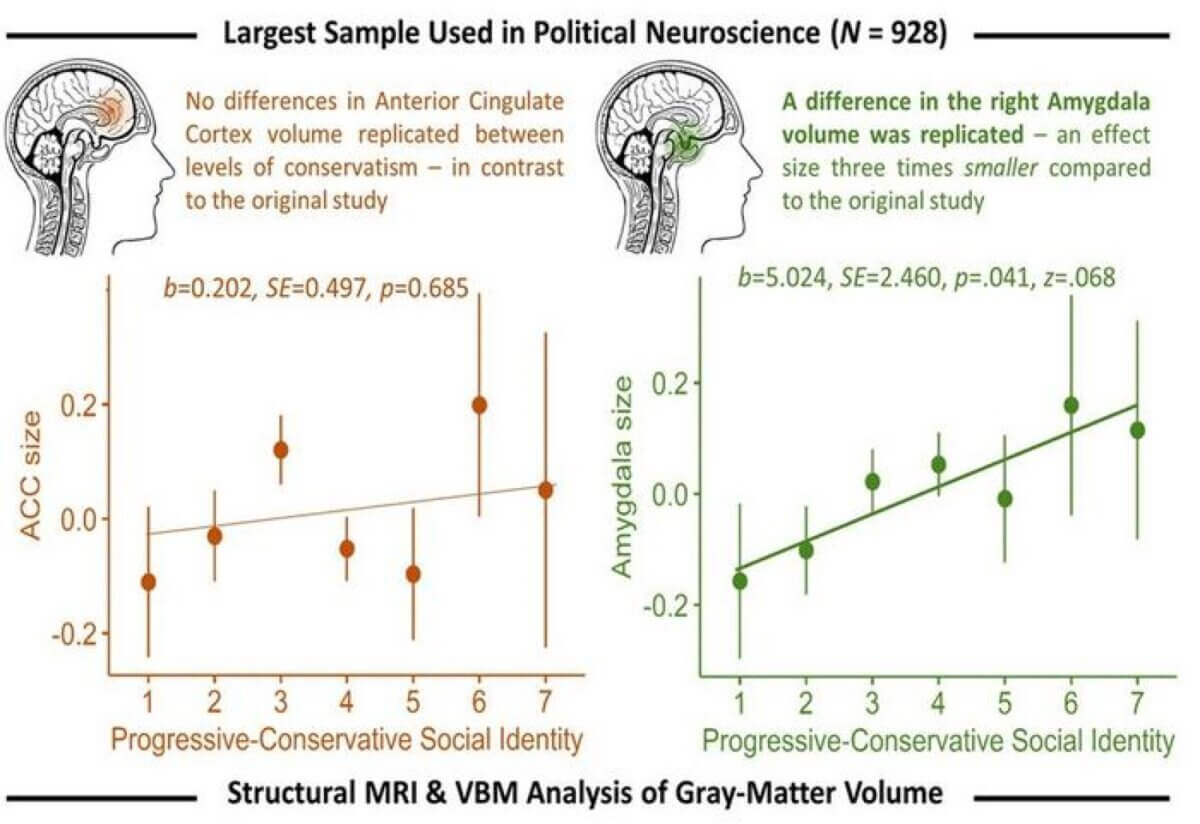

(© Supertrooper – stock.adobe.com)
ATHENS, Greece — A groundbreaking new study has reignited the debate over whether political ideology is linked to brain structure. While previous research suggested that conservatives have larger amygdalas – the brain’s fear center – and liberals have larger anterior cingulate cortices (ACC) – involved in conflict detection, this latest investigation paints a more nuanced picture.
The study, published in iScience, examined brain scans from nearly 1,000 Dutch adults, making it the largest analysis to date on the neurological underpinnings of political beliefs. Led by researchers Diamantis Petropoulos Petalas, Gijs Schumacher, and Steven Scholte, the team sought to replicate and expand upon a controversial 2011 study that first proposed structural brain differences between liberals and conservatives.
Using advanced brain imaging techniques, the researchers analyzed gray matter volume in key brain regions, including the amygdala and ACC. They also collected extensive data on participants’ political views, going beyond simple liberal-conservative labels to examine economic and social ideologies separately.
The results? While the study did find a small correlation between amygdala size and conservatism, the effect was much weaker than previously reported. Importantly, the researchers found no link between ACC volume and liberal beliefs, failing to replicate a key finding from the original study.
“It was really a surprise that we replicated the amygdala finding,” says first author Diamantis Petropoulos Petalas, a political psychology and neuroscience researcher from The American College of Greece, in a media release. “Quite honestly, we did not expect to replicate any of these findings.”

The study also broke new ground by examining other brain regions. Intriguingly, they found hints of a relationship between ideology and the fusiform gyrus, an area involved in face and object recognition. However, these results were not consistent across all analyses, highlighting the complexity of the issue.
What sets this study apart is its comprehensive approach to measuring political beliefs. Rather than relying on a simple left-right scale, the researchers examined economic and social ideologies separately. They also distinguished between self-identified political labels and actual policy positions.
“We see ideology as a complex, multidimensional product; that includes different attitudes on social and economic matters, as well as identification with progressive or conservative ideals; it’s really not just about the left or the right,” says Petropoulos.
“The amygdala controls for the perception and the understanding of threats and risk uncertainty, so it makes a lot of sense that individuals who are more sensitive towards these issues have higher needs for security, which is something that typically aligns with more conservative ideas in politics.”
The study’s large, diverse sample is one of its major strengths. While previous research often relied on small groups of college students, this investigation included nearly 1,000 Dutch adults from various backgrounds. This diversity helps ensure the findings are more representative of the general population.
So, what does this all mean for our understanding of political differences? The researchers caution against drawing too strong conclusions. While there may be some relationship between brain structure and ideology, it’s likely just one small piece of a much larger puzzle.
“We find a very nice positive correlation between the parties’ political ideology and the amygdala size of that person,” Petropoulos continues. “That speaks to the idea that we’re not talking about a dichotomous representation of ideology in the brain, such as Republicans versus Democrats as in the US, but we see a more fine-grained spectrum of how political ideology can be reflected in the brain’s anatomy.”
Paper Summary
Methodology
The researchers used magnetic resonance imaging (MRI) to scan the brains of 928 Dutch adults. They focused on measuring the volume of gray matter in specific brain regions, including the amygdala and anterior cingulate cortex. Participants also completed surveys about their political beliefs, covering both economic and social issues. The team then used statistical analyses to look for correlations between brain structure and political ideology.
Key Results
The study found a small, positive correlation between amygdala volume and conservative beliefs, but the effect was much weaker than in previous studies. They did not find a significant relationship between ACC volume and liberal beliefs. Some correlations were found between ideology and the fusiform gyrus, but these results were not consistent across all analyses.
Study Limitations
The study was conducted in the Netherlands, which has a multi-party political system different from the two-party system in the U.S., where much previous research was done. This could affect how political ideology is expressed and measured. Additionally, while the sample size was large, it was still limited to Dutch adults, potentially limiting generalizability to other populations.
Discussion & Takeaways
The researchers emphasize that while there may be some relationship between brain structure and political beliefs, the effects are small and likely just one factor among many that shape our ideologies. They stress the importance of using more nuanced measures of political beliefs in future research rather than simple left-right scales. The study also highlights the need for large, diverse samples in neuropolitical research to ensure findings are robust and generalizable.
Funding & Disclosures
The study was conducted using data from the Amsterdam Open MRI Collection. The authors declared no competing interests. Specific funding information was not provided in the report.
 Print
Print


